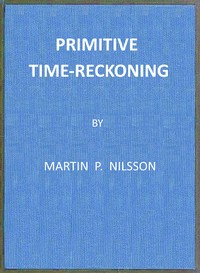Primitive Time-reckoning by Martin P. Nilsson
"Primitive Time-reckoning" by Martin P. Nilsson is a scholarly publication written in the early 20th century. This work delves into the origins and initial development of timekeeping among primitive and early cultures, investigating the various methodologies and units utilized by different peoples in tracking the passage of time. Nilsson’s study offers insights into how concepts of day, month, and year evolved from concrete natural observations into abstract numerical systems used for timekeeping.
The opening of the book sets the framework for this exploration by discussing the fundamental necessity of understanding primitive time-reckoning through comparative ethnological methods. Nilsson emphasizes that the development of calendar systems emerged from concrete, observable phenomena such as the movements of celestial bodies and natural seasonal changes, rather than being derived exclusively from technological advancements. He introduces the concept that the day, as experienced by primitive societies, is often divided into recognizable parts, based on cyclic events in nature, thereby laying the groundwork for further discussions on how various cultures structured their time-defining practices. (This is an automatically generated summary.)
Read or download for free
| How to read | Url | Size | |||
|---|---|---|---|---|---|
| Read now! | https://www.gutenberg.org/ebooks/64768.html.images | 1.2 MB | |||
| EPUB3 (E-readers incl. Send-to-Kindle) | https://www.gutenberg.org/ebooks/64768.epub3.images | 633 kB | |||
| EPUB (older E-readers) | https://www.gutenberg.org/ebooks/64768.epub.images | 642 kB | |||
| EPUB (no images, older E-readers) | https://www.gutenberg.org/ebooks/64768.epub.noimages | 472 kB | |||
| Kindle | https://www.gutenberg.org/ebooks/64768.kf8.images | 981 kB | |||
| older Kindles | https://www.gutenberg.org/ebooks/64768.kindle.images | 919 kB | |||
| Plain Text UTF-8 | https://www.gutenberg.org/ebooks/64768.txt.utf-8 | 901 kB | |||
| Download HTML (zip) | https://www.gutenberg.org/cache/epub/64768/pg64768-h.zip | 589 kB | |||
| There may be more files related to this item. | |||||
Similar Books
About this eBook
| Author | Nilsson, Martin P. (Martin Persson), 1874-1967 |
|---|---|
| Translator | Fielden, F. J., 1882- |
| LoC No. | 21016502 |
| Title |
Primitive Time-reckoning A study in the origins and first development of the art of counting time among the primitive and early culture peoples |
| Series Title | Skrifter utgivna av Humanistiska vetenskapssamfundet i Lund ... 1 |
| Note | Reading ease score: 68.1 (8th & 9th grade). Neither easy nor difficult to read. |
| Credits | Turgut Dincer, John Campbell and the Online Distributed Proofreading Team at https://www.pgdp.net (This file was produced from images generously made available by The Internet Archive) |
| Language | English |
| LoC Class | CE: History: Technical Chronology, Calendar |
| Subject | Chronology |
| Category | Text |
| EBook-No. | 64768 |
| Release Date | Mar 9, 2021 |
| Copyright Status | Public domain in the USA. |
| Downloads | 334 downloads in the last 30 days. |
| Project Gutenberg eBooks are always free! | |


